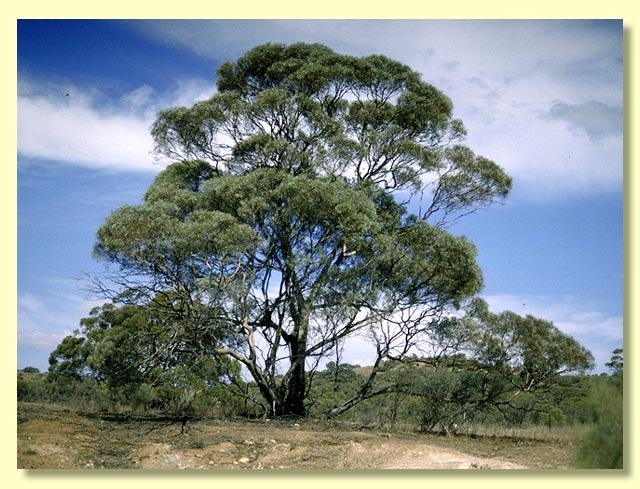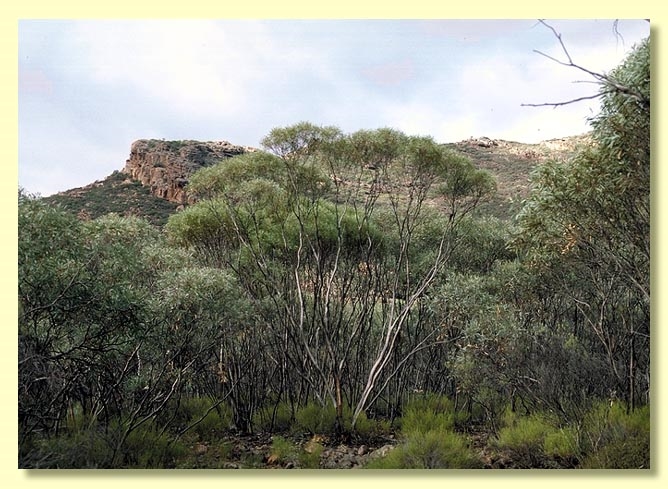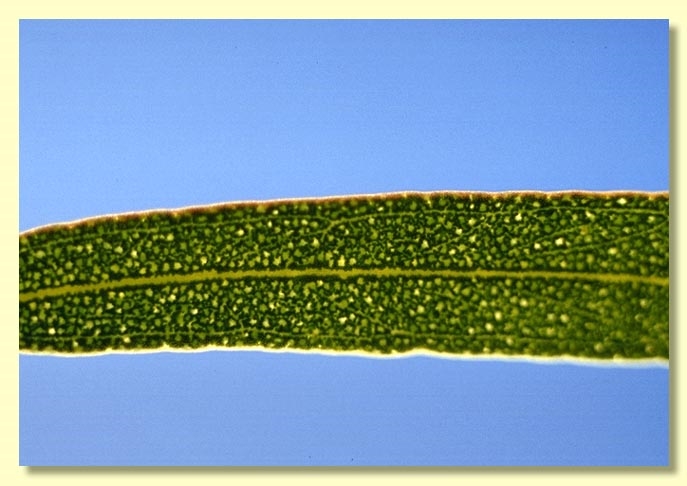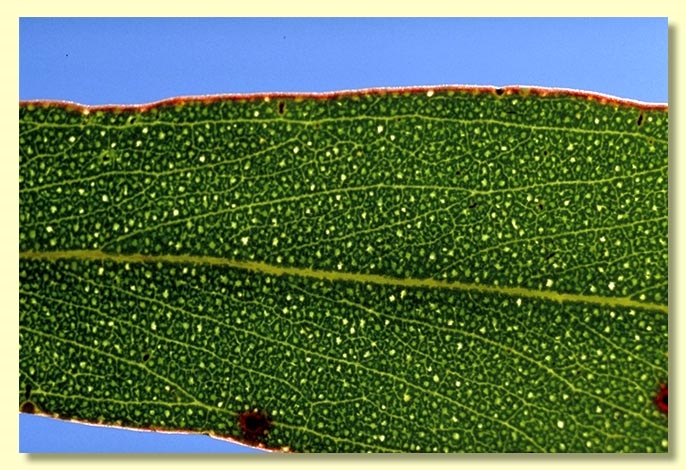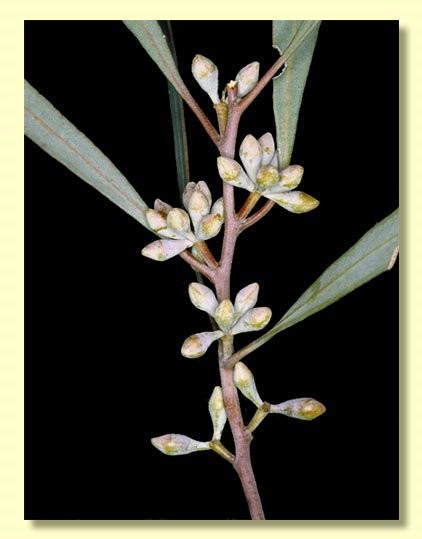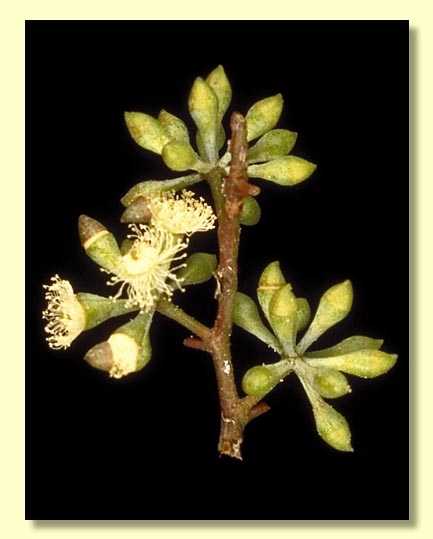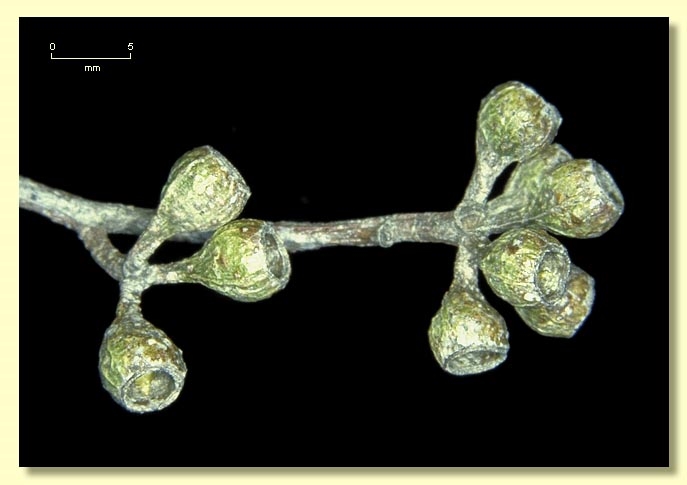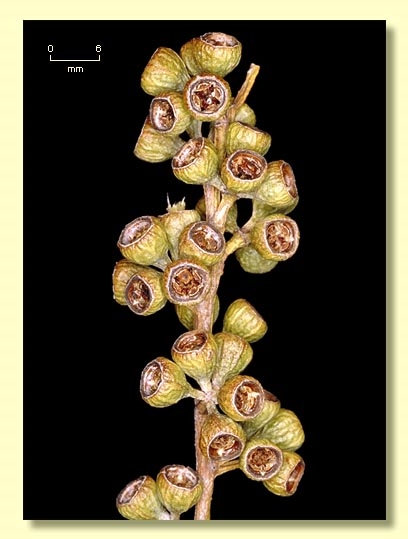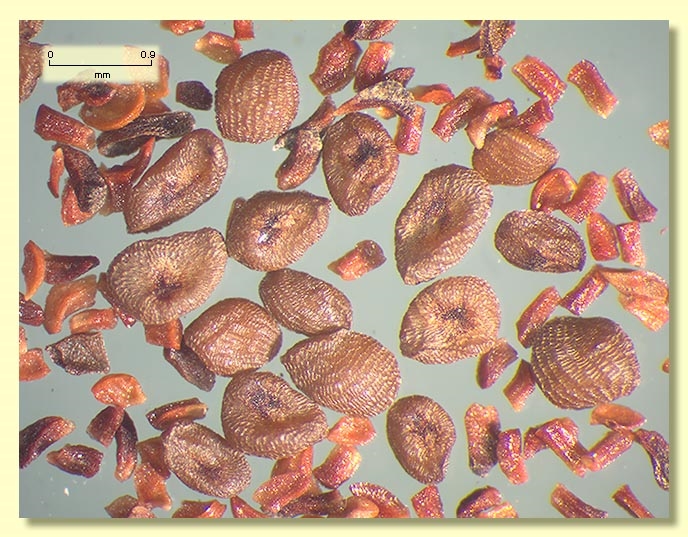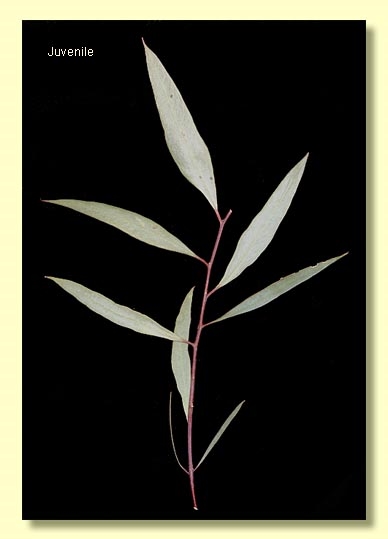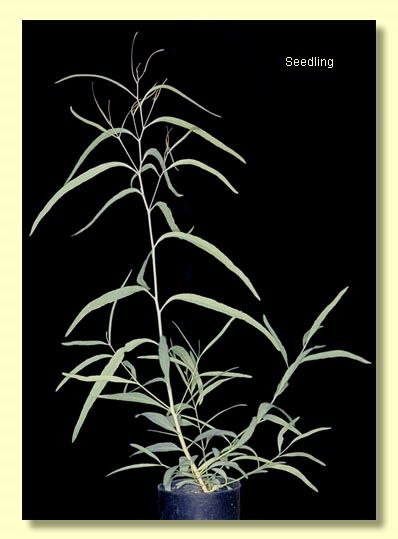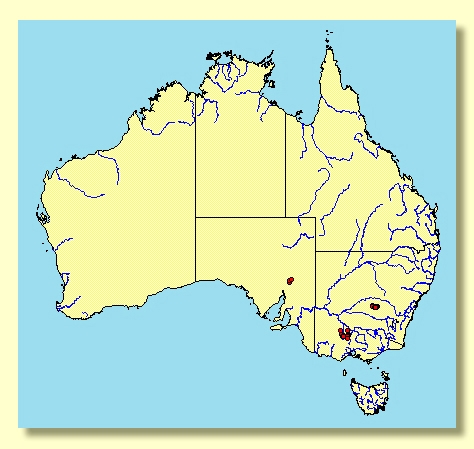Euclid - Online edition
Eucalyptus polybractea
Eucalyptus | Symphyomyrtus | Adnataria | Apicales | Buxeales | Continentes
Eucalyptus polybractea R.T.Baker, Proc. Linn. Soc. New South Wales 25: 692 (1901).
T: West Wyalong, NSW, Dec. 1900, R.H.Cambage s.n.; holo: NSW; iso: K.
Eucalyptus filiformis Rule, Muelleria 20: 24-27 (2004); T: Victoria, Southern slope of Mt Jeffcott, K.Rule 9933, 8.vi.1999; holo: MEL.
[E. fruticetorum auct. non F.Muell. ex Miq.: W.F.Blakely, Key Eucalypts 228 (1934).]
[The following two unpublished names were used for Flinders Ranges populations of E. polybractea in earlier deitions of EUCLID. They are now included here:
Eucalyptus illucens L.A.S.Johnson MS [nom. inval.], in Brooker, M.I.H., Slee, A.V., Connors, J.R. & Duffy, S.M., (2002) EUCLID Eucalypts of southern Australia Edn. 2.
Eucalyptus sp. Flinders Ranges (D.Nicolle 562) D.Nicolle, in Centre for Plant Biodiversity Research, (2006) EUCLID Eucalypts of Australia Edn. 3].
Bark rough, box-type and pale grey to grey-brown on lower 1–2 m of stems; smooth light grey to dark grey, brown or pinkish, at times with ribbons of decorticated bark in the upper branches; smaller regenerating plants that are at flowering stage may be entirely smooth-barked; branchlets usually glaucous or rarely non-glaucous.
Juvenile growth (coppice or field seedlings to 50 cm): stem rounded or square in cross-section, glaucous or non-glaucous; juvenile leaves always shortly petiolate, opposite for 4 or 7 nodes then alternate, lanceolate to linear, 4–15 cm long, (0.2)0.3–1.6 cm wide, base tapering to petiole, usually blue-grey or glaucous.
Adult leaves alternate, petiole 0.4–1.5 cm long; blade lanceolate, 6–17 cm long, 0.4–2 cm wide, base tapering to petiole, concolorous, dull, blue-green, blue-grey or glaucous, side-veins very acute, sparsely or obscurely reticulate, intramarginal vein parallel to and remote from margin, oil glands mostly island, or obscure.
Inflorescence axillary unbranched, peduncles 0.4–1.2 cm long, buds 7, 9 or 11 per umbel, pedicel 0–0.4(0.6) cm long. Mature buds clavate to diamond-shaped, 0.4–0.6(0.8)cm long, 0.3–0.4 cm wide, green or glaucous, scar absent, operculum conical to rounded, stamens irregularly flexed, anthers adnate, globoid, dehiscing by small lateral pores, stigma blunt or pin-head shaped, locules 3 or 4(5), the placentae each with 4 vertical ovule rows. Flowers white.
Fruit pedicels 0.1–0.6 cm long, cup-shaped or barrel-shaped, 0.4–0.7 cm long), 0.3–0.5 cm wide, disc descending, valves 3 or 4(5), near rim level or enclosed.
Seeds brown, 0.5–1.5 mm long, flattened-ovoid, dorsal surface shallowly pitted, hilum ventral.
Cultivated seedlings (measured at ca node 10): cotyledons reniform to oblong; stems rounded or square in cross-section, usually glaucous; leaves petiolate, opposite for 3 or 5 pairs then alternate, linear to lanceolate, 4.5–14 cm long, 0.4–1.5 cm wide, base tapering, margin entire, apex pointed, dull, blue or glaucous.
Flowering has been recorded in March, April, May, June, August and November.
A mallee box species widespread but sporadically distributed in south-eastern Australia, with main centres near West Wyalong in New South Wales, Bendigo to Stawell in Victoria, and from near Quorn north through the Flinders Ranges to the Gammon Ranges in South Australia. Eucalyptus polybractea is a distinctive species, differing from other mallee eucalypts by its box bark (on larger plants), glaucous buds in axillary clusters of 7, 9 or 11 and dull bluish to glaucous juvenile and adult leaves. The adult leaves also smell very strongly of eucalyptus oil when crushed.
In the classification of Brooker (2000) Eucalyptus polybractea belongs in Eucalyptus subgenus Symphyomyrtus section Adnataria because the buds have two opercula, ovules are in four rows, seeds flattened-ovoid, cotyledons reniform, and anthers rigid on the staminal filaments. Within section Adnataria, E. polybractea is part of a subgroup, series Buxeales subseries Continentes, further distinguished by having buds that retain the outer operculum until flowering time when both opercula are shed together. Most species in this group are from eastern Australia and have all stamens fertile and are woodland trees of hills and plains, often dominant in the landscape, viz. E. albens, E. moluccana, E. microcarpa and E. pilligaensis. Others, viz. E. viridis, E. polybractea, E. froggattii, E. odorata, E. albopurpurea and E. porosa, are mallees, some of them also occurring as small trees occasionally.
Eucalyptus polybractea is most likely to be confused with two other mallee box species, E. viridis and E. odorata. The narrow juvenile and adult leaves, axillary inflorescence arrangement and similar fruit shape shows their close relationship. E. viridis has green foliage, glossy at least in the adult leaves and is never glaucous; the bark on larger plants is usually a rough stocking like E. polybractea. E. odorata usually has non-glaucous branchlets, leaves and buds, with the adult leaves dull at first but maturing glossy green, and it has extensive rough firm bark extending to the branches ca 5-10 cm diameter–it often looks to be a "heavier-boled" tree or mallee than E. polybractea or E. viridis .
The Victorian endemic species E. filiformis Rule, described in 2004, is here included in E. polybractea as the type specimen matches material from the Flinders Ranges.



